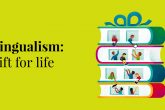
The summer holidays are drawing to a close and it’s time to go back to school! It won’t be long until your classroom is full of excited students, itching to see their classmates again after the summer break.
Are you ready to kick off the new year? We’ve put together some tips to help you start the year off on the right foot. We’ve even thrown in some games, articles, and resources for you too.
The first class back
The first few classes of the new term set the tone for things to come. It’s a fresh start for old students and a new beginning for those who are joining you for the first time. At some point in your first week, it’s important to talk seriously about classroom behaviour and make sure students know what is expected of them.
Of course, the teacher should have authority in the classroom. However, the best way to get students on board with your rules is to involve them in the process. Begin with a discussion about how they should act in the classroom. This could culminate in a classroom contract, which all students should create, agree to, and sign.
Here are some example questions to guide the discussion (you may need to adapt these depending on your students’ age group or subject):
-
Why is learning important to you?
-
How will this subject benefit you in the future?
-
What should you do when the teacher is talking?
-
Is it okay to make a mistake? How should we treat people who make mistakes?
-
Can you use mobile phones in class?
-
Is bullying acceptable? What are some examples of bullying we should avoid?
By asking students these questions – and others which you feel are important – you can shape the rules. If students disagree with a rule, encourage them to argue why that is.
As students are involved in the discussion, they will feel more ownership of the rules and are more likely to take them seriously. However, although this is a “negotiation”, remember that you always have the power to veto rules or set your own!
Finally, have students create a poster for the classroom wall (if appropriate), and ask everyone to sign it.
Setting Learning Goals
There’s no question, students do better when they have clear learning goals to work towards during the year. Not only do goals provide motivation and accountability, but they also mark student progress throughout the year.
Community member Batool Kazmi, who teaches at the International School Of Karachi says “I ask my kids about the goals they have to achieve this year, so I can help them.” Batool has a great approach and attitude – not only does this personalise the experience for the learners, it also lets them know the teacher is there to help them.
When setting goals, we recommend making sure they are SMART – that is Specific, Measurable, Attainable and Time-bound. You can read more about setting SMART goals in our post: Back to school: 5 ways to establish SMART goals.
Establishing an inclusive classroom
An inclusive classroom is one that serves every student’s learning needs, respects and celebrates differences, makes everyone feel welcome, and creates a strong bond between classmates.
You can start by talking about the languages your students speak, their hobbies, interests, cultural backgrounds, etc. We love the “How are we the same” activity, as described in this blog post, 5 activities to celebrate international friendship day. It’s a great icebreaker that gets students talking about themselves:
First, ask students to sit next to someone they don’t usually work with. They should draw two circles on a piece of paper (see Venn diagram below):
Each student should write their name over one of the circles. Then explain that they should take it in turns to say something about themselves. If the partner can answer “me too”, they should write the statement in the centre, where the circles overlap. If the partner cannot say “me too”, they should write the statement in the outside circles. After ten minutes, the students should share their differences and what they have in common and with the rest of the class.
Helping students get to know one another is an important part of an inclusive classroom – and so is making sure everyone is given the same opportunities to learn. It’s therefore important to make sure your activities are designed to include students with special educational needs in a way that does not single them out.
If you have a neurodiverse student with dyslexia, ADHD, autism, or a student with a physical disability, it’s important to design activities that incorporate their learning needs from the beginning. Here are a few tips to help make your classroom more inclusive:
-
Make sure instructions are very clear
-
Be flexible; allow students to answer questions in diverse ways (in writing, drawing, orally,etc.)
-
Ensure that worksheets are simple to read and aren’t cluttered with information
-
Concept check to ensure students understand instructions right away
-
Keep activities short and focused to account for shorter attention spans
-
Have fast finisher activities on hand to make sure all students have time to finish
-
Establish a classroom routine to help students feel secure in their learning
If you’d like to learn more about being inclusive, see our articles: Talking with Varinder Unlu about the importance of being more inclusive and Teaching children with autism: Strategies for the international school classroom.
There is also a lot of useful advice on developing an inclusive classroom in this article, The General Ed Teachers’ guide to the inclusive classroom.
Building a routine
Finally, it’s important to establish (or reinforce) a routine with your new students at the beginning of the term. Routines lay the foundation for a safe space for learning – and they can benefit students of all ages.
Routines can help you manage energy levels and put students in the right frame of mind for learning. By having an established set of actions for different activities, you can reduce the need for lengthy instructions and have students automatically get in activity mode. Soon, the beginning of class, continual assessment, group work, playing a game, clearing up and so on will fall into place and classroom management will become far easier. In addition, routines help students feel more confident – they know what they have to do, so they feel more in control and happier.
But perhaps the biggest advantage of routines is that you can sometimes break them and make things exciting for your students!
Looking for more ideas? Here are six opening and closing routines for new teachers.

